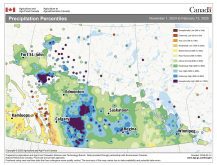Editor’s note: This is the sixth of a series of columns looking at the lessons learned from the financial crisis of 2008.
The 2008-09 financial crisis was a disaster for tens of millions of people around the world, destroying jobs, savings and dreams.
Many have not recovered from the damage it dealt. Some never will.
But it was also an incredible opportunity for market watchers to study the world’s markets and financial systems in a truly extreme situation, in which prices, technologies, structures and theories could be analyzed, like sub-atomic particles being examined in the Large Hadron Collider.
Read Also

Huge Black Sea flax crop to provide stiff competition
Russia and Kazakhstan harvested huge flax crops and will be providing stiff competition in China and the EU.
I found it fascinating throughout the crisis years to examine my assumptions and to challenge theories I’ve held or dismissed.
Other stories in this series:
- Remembering the lessons from the 2008 financial crisis
- Hedging makes sense, but manage them
- Knowing your lender when times get rough pays dividends
- Manage farms like low-margin, high-volume businesses
- 2008 crisis showed importance of interest rates
- Farmers can learn lessons from 2008 financial crisis
Notions such as “linkage,” which was a mid-2000s concept about the flood of speculative and algorithm-driven money causing all asset classes to move in lockstep, could be examined from another angle when money went flooding out instead. When does linkage occur? When does it disappear?
For me, the most interesting theory to study was one that I still hold dear to my analytical heart, which is the family of theories about stock market and commodity market cycles operating in opposition, with many-year stock market rallies interchanging with many-year commodity market rallies. When a long-term stock market rally is occurring, commodity markets should be in a long-term bear market. When commodities take the lead, stock markets should fall into a long-term bear market.
This theory had been knocking around in arcane academic circles before the 2000s, but famed investor Jim Rogers brought it to general attention in 2004 with his book Hot Commodities, and I devoured it and tested it against what I knew of commodity market history.
It seemed a sound theory to me, and it quickly caught fire with hundreds of thousands of investors, and eventually with the initially dismissive mainstream Wall Street set.
As oil prices took flight in the early 2000s and virtually all other commodity classes joined them, the theory seemed to be working, especially as stock markets had trouble climbing out of the 2000-02 recession.
However, as commodities continued to roar ahead in the mid-2000s, so too did stock markets recover and steadily rise. Instead of a continuing bear market in stocks to provide a mirror image of commodities, as the theory suggested, it looked like the two distinct classes of market had become linked and were capable of experiencing simultaneous bull markets. (Recall the linkage reference above?)
Agricultural commodities were very late to the party, really only joining in 2005-06, but they joined with a vengeance, with some surging to incredible levels.
When the crisis hit, commodities also collapsed as stock markets fell. Linkage had continued as everything reversed.
So, did the simultaneous rise and fall of stocks and commodities disprove the theory of alternating markets?
That’s what the period since 2009 has allowed us to examine. What have we found?
As anybody living in the commodity markets has seen, including almost all farmers, commodity markets quickly recovered, with some hitting new peaks, while stock markets merely limped back toward their peaks hit in 2000 and 2007.
Commodities continued strongly into 2013-14, and then fell into an extended bear market that we are still within. As commodities fell, limping economies hit by the financial crisis recovered and in late 2016 a strong stock market rally commenced. Stocks were strong while commodities struggled with weakness.
To me it looks like we have left a long-term commodity bull market behind and moved into a long-term stocks bull market. Others will view it differently, seeing no such dynamics at play.
But the crisis allowed me to look at the question closely and refine my views, so for that I will always value the opportunity it provided. In the early 2000s I held a crude version of the theory. Now I have a more nuanced appreciation of its complexities. That’s what the crisis has given to me.
Next week I’m going to tie up this series of “Lessons Learned” with a summary of what I’ve picked up from speaking with analysts and economists, as well as from walking back through my own experiences of covering it.

















